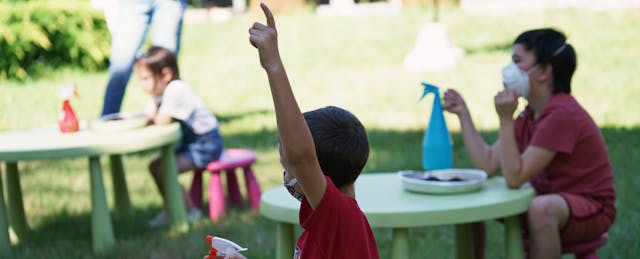2020 will be recorded in the history books as a year of deep tragedies, inequities and heartache. We hope it will also be remembered as the year education broke free of the four walls of our school buildings and embraced the healthy, fresh air outside.
This year, the fields of outdoor learning and green schoolyards reached a tipping point, as thousands of schools around the country took their chairs, desks and easels—and log stumps, straw bales, picnic blankets and Wi-Fi—outside, to study under leafy tree canopies and shady tents.
The national movement to use outdoor learning as a means to reopen schools during the pandemic was shepherded by the National COVID-19 Outdoor Learning Initiative, co-founded by Green Schoolyards America; the Lawrence Hall of Science at the University of California, Berkeley; San Mateo County Office of Education; and Ten Strands. We chose to focus on outdoor learning because we knew—and everyone saw in the spring—that distance learning massively exacerbates the inequities in our education system.
Ten months into the pandemic, there are still too many students who don’t have access to devices and reliable broadband, and who live in home environments that are not conducive to virtual learning. For these students in particular, and all students in general, we’re asking school district and site leaders to consider using—or continue using—their outdoor spaces for learning, because the risk of virus transmission is roughly 20 times lower outdoors than indoors.
We know from research and experience that expanding the classroom into outdoor spaces, both on and off school grounds, will address academic, health and economic needs—during this pandemic and long after. Spending time outdoors is critical to students’ intellectual, physical and mental well-being.
Outdoor environments typically have better air quality than indoor ones, and environmental conditions such as wind and sunlight may reduce the amount of virus present and the length of time the virus can stay viable. Outdoor classrooms are also one of the most cost-effective ways to increase school capacity. If schools are able to safely accommodate more students by going outside, there will be less disruption in the lives of students and families. Holding class outside also makes it more likely that schools will be able to reliably remain open, once students return to school.
Our approach is multifaceted and interdisciplinary. It includes creating “how-to” resources, frameworks and strategies designed to help schools and districts plan their outdoor infrastructure, expand to use outdoor spaces at nearby parks, consider new staffing models (formal/informal partnerships) and integrate additional school programs outdoors such as physical education, recess and meals. Our resources also offer guidance on engaging the community in the planning process, understanding health considerations, influencing local and state policy and exploring funding and economic models.
We set up this outdoor learning initiative as a collective impact project, and from our launch in early June it has grown more rapidly than any project we have previously worked on. We are profoundly grateful to everyone who has joined us and in awe of how creative people can be when the established way of doing things is not possible. The creative capacity in all of us to innovate and adapt has never been more on display than during this pandemic. This is something we want to bring forward with us, when we’re on the other side of this crisis.
The incoming Biden-Harris administration talks about "building back better"—a strategic approach based on a United Nations framework aimed at reducing the risk to the people of nations and communities in the wake of future disasters and shocks. We see the benefit of this strategic approach in our world, too. When schools choose to focus on creating ecologically resilient outdoor learning spaces—many of which amount to long-term investments and district-wide commitments to outdoor education—they are able to offer more equitable access to rich learning experiences for children, both during the pandemic and long after.
Every other Tuesday, we convene educational institutions that are working to take learning outdoors. EdSurge readers are welcome to join us. This free, public group is national in scope and includes state agency representatives; county, district and site leaders; and community partners. Together, they are using the resources being developed (before the ink is even dry), sharing their expertise and challenges—and innovating on behalf of, and with, teachers and students in their communities. We’re beginning to tell their stories to inspire and support others. Our case study library is growing, and you can see their work in action here.
In early December, during a call with an independent school in Oakland, Calif., school leaders there shared that they started their journey by reviewing early drafts of the resources we published and by visiting a local school that was further along. Before the pandemic, student learning at this school was mostly taking place outdoors during “garden time.” Today, 75 percent of all instruction is happening outside. The teachers there who have embraced teaching outside say they don’t see the need to return to the way instruction used to be.
While we were on the video call, two third-graders showed up with masks on. We asked them how it was for them to be learning outside. “Cold,” “fun” and “good” were their responses. We asked what they did when they were cold. “We put on a jacket and move,” they replied.
So there you have it: Put on a jacket and move, and a whole new way of teaching and learning will open up to you, during the pandemic and beyond.
This op-ed is part of a series of year-end reflections EdSurge is publishing as 2020 concludes.


